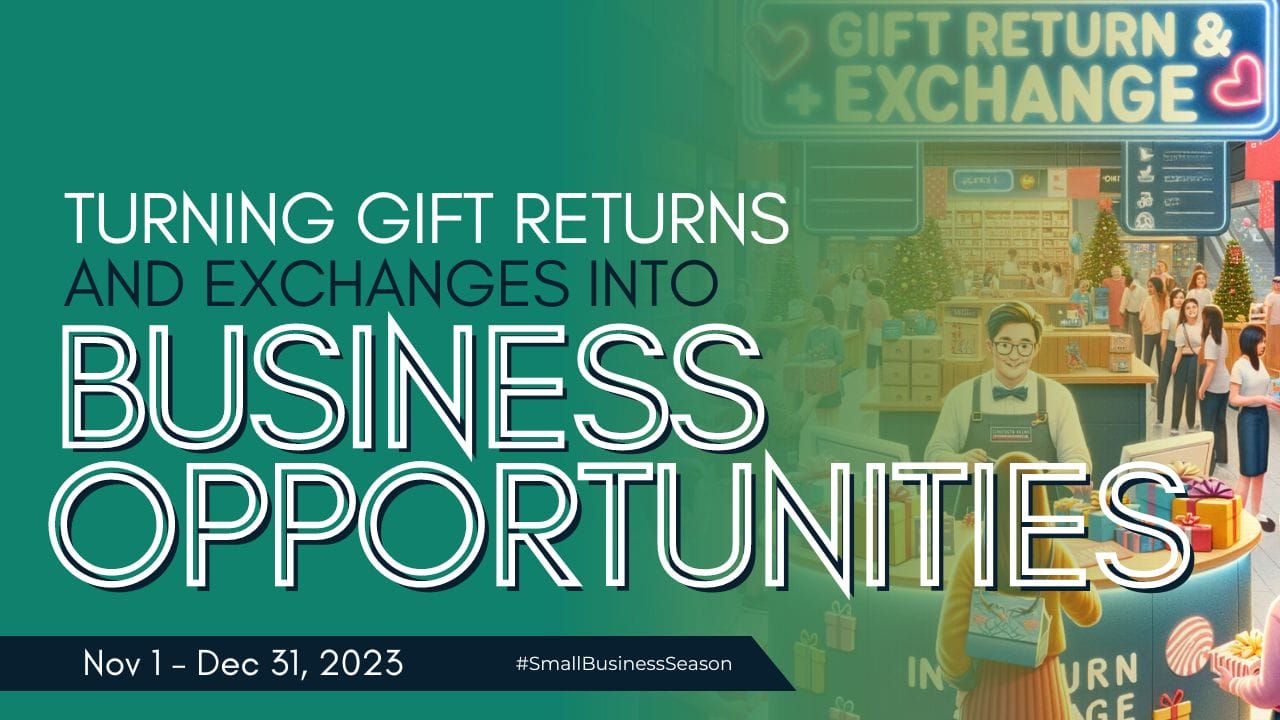Small Business Season: Returns and Exchanges
Turning Gift Returns and Exchanges into Business Opportunities
You hate to see it coming—a customer with your bag in hand entering the door. You know where that’s headed. No matter how helpful you were or how great your products are, the holiday season isn’t complete without a wave of gift returns and exchanges. While it's easy to view these transactions as inconveniences, savvy businesses recognize the untapped potential these transactions hold.
There’s an art to handling gift returns and these strategies will help you transform them into valuable opportunities for building customer loyalty and business growth.

What Every Business Must Know About Returns
A return is not a personal attack. But it is a way to create an army of loyal customers. While you want to safeguard against fraud and theft returns, taking the pain out of returns may cause people to buy from you in the future. Costco and Nordstrom have loyal followings because of their liberal return policies. Here are a few tips to ensure your policies are just as appealing.
Streamline the Return Process
The first step in mastering gift returns is to ensure that the process is as smooth and hassle-free as possible. Simplify your return policy, clearly communicate it to customers, and invest in user-friendly return systems. An easy return experience fosters customer trust and sets the stage for positive interactions.
Convert Returns into Exchanges
Encourage customers to consider exchanges rather than outright returns. Create incentives, such as limited-time discounts or exclusive offers, to motivate customers to explore alternative products. Turning returns into exchanges not only retains revenue but also introduces customers to a broader range of your offerings.
Gift Return Specials
Offer exclusive promotions or discounts for customers returning gifts. This not only turns a potentially negative experience into a positive one but also demonstrates your commitment to customer satisfaction. Additionally, you can incentivize them to upgrade to a higher-priced product by offering a discount or bundle deal. This can increase your average order value.
Consider bundling returned items with complementary products to create attractive package deals. You can even give the packages funny names for “bad” gift givers to attract attention such as “I told him I hated orange” or “Next year I’m giving him coal.” Use this approach in your in-store signage as well. Levity helps brighten the mood around a return.
Leverage Customer Feedback
Use gift returns as an opportunity to gather valuable feedback. Implement surveys (at the register with QR codes) or ask customers for input during the return process. Understanding the reasons behind returns can provide insights into product issues, customer preferences, and areas for improvement, helping you refine your offerings.
Create a Seamless Experience Everywhere
Ensure a consistent and seamless experience across all channels, whether customers make returns in-store or online. Integrating your online and offline systems not only improves efficiency but also enhances the overall customer experience. A unified approach strengthens customer relationships and fosters brand loyalty. Additionally, returning things online has a bad reputation. If you can make it easy, people won’t hesitate to buy from you online in the future. Convenience is key to future buys.
Personalized Communication
Tailor your communication during the return process. Personalized emails or messages expressing empathy and understanding go a long way in building customer trust. Provide clear instructions on the return/exchange process and keep customers informed about the status of their transactions.
Build a Return-Friendly Culture
Cultivate a return-friendly culture within your business. Emphasize the importance of customer satisfaction to your team and empower them to handle returns with a positive mindset. A customer-centric approach builds trust and positions your brand as responsive and reliable. Don’t consider a return a failure but an open door to win them over in the future.
Deepen Customer Relationships
Train your staff on the following best practices:
- Go beyond the transaction. Instead of a robotic exchange, actively listen to why they want to return. Is it the wrong size? Not what they expected? This opens the door to personalized recommendations, suggesting other products that better suit their needs.
- Understand if it was a gift. Before you fall all over yourself apologizing for a lack of quality or whatever the case may be, make sure you understand the nature of why they’re bringing it back. It could be that their significant other bought the wrong size or the cologne smells too much like his mother. Knowing this information can help you make a valuable recommendation, and it also provides an opportunity to build a relationship. We’ve all gotten gifts that just weren’t right for us but that doesn’t mean that everything you sell is that way. Sometimes the recipient just needs a little nudge to finding what they love. If they bought the item themselves and are dissatisfied...
- Turn complaints into compliments. If a product falls short, don't just refund their money. Offer a discount on a similar item, a gift certificate, or even store credit that incentivizes them to return. This shows you care about their satisfaction and want to keep them as customers.
- Use returns as market research. Track what items are returned most frequently. Are there quality issues? Is the product description somehow misleading? Identifying common return reasons can help you improve your product line and messaging in the future.
- Analyze return patterns. Do certain categories see more returns during specific seasons? This data can inform your inventory management and marketing strategies for future holiday seasons.
- Go the extra mile. Offer to gift wrap exchanged items for free, include a handwritten note of apology or appreciation, or provide a small token of goodwill. These small gestures can transform a frustrated customer into a loyal advocate.
- Promote "second chance" items. Create a dedicated section for returned items in good condition and offer them at a discounted price. This attracts bargain hunters and clears out inventory.
Mastering the art of gift returns is not just about mitigating losses but seizing opportunities to strengthen (or build) customer relationships and drive business growth. By making it a good return experience, you can transform the post-holiday return season into a strategic advantage. Watch as these opportunities unfold into long-term customer loyalty and satisfaction.
This article is part of the Small Business Season series provided by the Chamber Pros Community.
